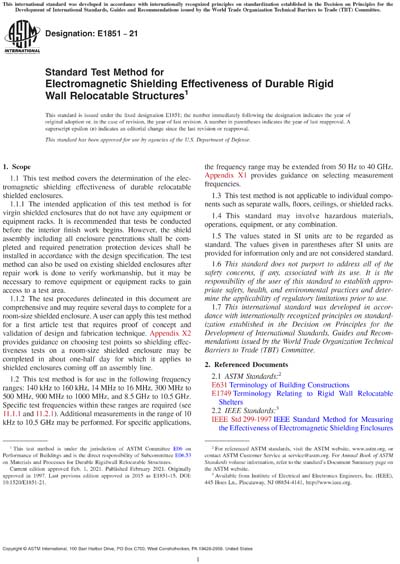Most recent
ASTM E1851-21
Standard Test Method for Electromagnetic Shielding Effectiveness of Durable Rigid Wall Relocatable Structures
1.1 This test method covers the determination of the electromagnetic shielding effectiveness of durable relocatable shielded enclosures.
1.1.1 The intended application of this test method is for virgin shielded enclosures that do not have any equipment or equipment racks. It is recommended that tests be conducted before the interior finish work begins. However, the shield assembly including all enclosure penetrations shall be completed and required penetration protection devices shall be installed in accordance with the design specification. The test method can also be used on existing shielded enclosures after repair work is done to verify workmanship, but it may be necessary to remove equipment or equipment racks to gain access to a test area.
1.1.2 The test procedures delineated in this document are comprehensive and may require several days to complete for a room-size shielded enclosure. A user can apply this test method for a first article test that requires proof of concept and validation of design and fabrication technique. Appendix X2 provides guidance on choosing test points so shielding effectiveness tests on a room-size shielded enclosure may be completed in about one-half day for which it applies to shielded enclosures coming off an assembly line.
1.2 This test method is for use in the following frequency ranges: 140 kHz to 160 kHz, 14 MHz to 16 MHz, 300 MHz to 500 MHz, 900 MHz to 1000 MHz, and 8.5 GHz to 10.5 GHz. Specific test frequencies within these ranges are required (see 11.1.1 and 11.2.1). Additional measurements in the range of 10 kHz to 10.5 GHz may be performed. For specific applications, the frequency range may be extended from 50 Hz to 40 GHz. Appendix X1 provides guidance on selecting measurement frequencies.
1.3 This test method is not applicable to individual components such as separate walls, floors, ceilings, or shielded racks.
1.4 This standard may involve hazardous materials, operations, equipment, or any combination.
1.5 The values stated in SI units are to be regarded as standard. The values given in parentheses after SI units are provided for information only and are not considered standard.
1.6 This standard does not purport to address all of the safety concerns, if any, associated with its use. It is the responsibility of the user of this standard to establish appropriate safety, health, and environmental practices and determine the applicability of regulatory limitations prior to use.
1.7 This international standard was developed in accordance with internationally recognized principles on standardization established in the Decision on Principles for the Development of International Standards, Guides and Recommendations issued by the World Trade Organization Technical Barriers to Trade (TBT) Committee.
Content Provider
ASTM International [astm]






